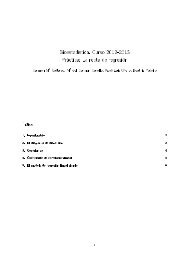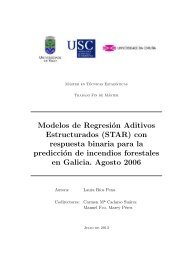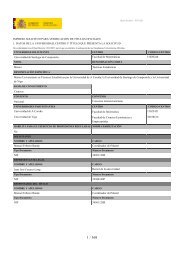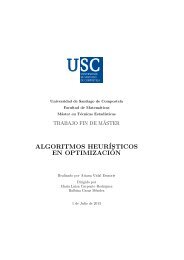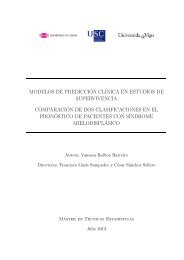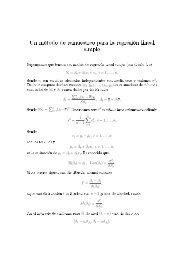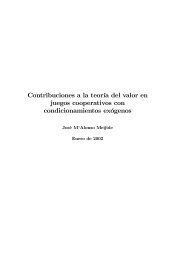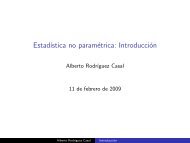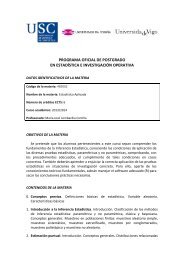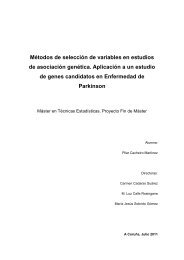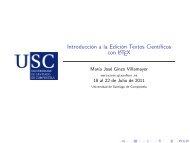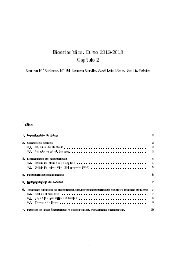Under H 0 , we have considered the model parameter Θ 0 (t) = 0, t ∈ [0, 1], whereas under H 1 , theselected model parameter was Θ 1 (t) = sin(2πt 3 ) 3 , t ∈ [0, 1]. Furthermore, under H 0 we have chosenσ = 1, while in the alternative H 1 we assigned the three different values that were commentedbe<strong>for</strong>e. Let us remark that both X and Θ were discretized to 100 equidistant design points.We have selected the statistical <strong>test</strong>s which were introduced in the previous section: (8), (9), (10)and (11). For (8), three distribution approximations were considered: the asymptotic approach(N (0, 2)) and the following two bootstrap calibrations⎛⎞T ∗(a) 11,n = √ ⎝ ṋ ∑k n(∆ ∗ n(ˆv j )) 2kn σ 2− k n⎠ ,T ∗(b)1,n =j=1⎛1√ ⎝nkn (ˆσ ∗ ) 2k n ∑j=1ˆλ j(∆ ∗ n(ˆv j )) 2ˆλ j− k n⎞⎠ .The difference between the two proposed bootstrap approximations is that in the latter the estimationof σ 2 is also bootstrapped in each iteration. On the other hand, <strong>for</strong> (9), (10) and (11), onlythe bootstrap approaches were computedT ∗ 2,n =T ∗ 3,n =k n ∑j=11∥n(∆ ∗ n(ˆv j )ˆλ j) 2,i=1T ∗ 3s,n = 1ˆσ ∗ ∥ ∥∥∥∥1nn∑(X i − ¯X)(Y i − Ȳ )ε∗ i∥ ,n∑(X i − ¯X)(Y i − Ȳ )ε∗ i∥ .i=1For this simulation study, we have used the “wild” bootstrap algorithm introduced in Section 2.4<strong>for</strong> the F–<strong>test</strong> and its studentized version, and the following adaptation of this consistent “wild”bootstrap <strong>for</strong> T 1,n and T 2,n .Algorithm 3 (Wild <strong>Bootstrap</strong>).Step 1. Compute the value of the statistic T 1,n (or the value T 2,n ).Step 2. Draw {ε ∗ i }n i=1i = 1, . . . , n.a sequence of i.i.d. random elements ε, and define Y∗i = Y i ε ∗ i <strong>for</strong> allStep 3. Build ∆ ∗ n(·) = n −1 ∑ ni=1 〈X i, ·〉Yi ∗ <strong>for</strong> all i = 1, . . . , n, and compute a n = |T1,n ∗ | (orb n = |T2,n ∗ |).Step 4. Repeat Steps 2 and 3 a large number of times B ∈ N in order to obtain a sequence ofvalues {a l n} B l=1 (or {bl n} B l=1 ).Step 5. Approximate the p–value of the <strong>test</strong> by the proportion of values in {a l n} B l=1greater than orequal to |T 1,n | (or by the proportion of values in {b l n} B l=1 greater than or equal to |T 2,n|).Let us indicate that 1, 000 bootstrap iterations were done in each simulation.Due to k n and α must be fixed to run the procedure, the study was repeated with different numbersof principal components involved (k n ∈ {1, . . . , 20}) and confidence levels (α ∈ {0.2, 0.1, 0.05, 0.01}).12
Nevertheless, in order to simplify the reading, the in<strong>for</strong>mation collected in the following tables correspondsto only three of the values of k n which were analyzed: k n = 5, k n = 10 and k n = 20.n50100N (0, 2) T ∗(a)1,n T ∗(b)1,n T2,n∗α k n k n k n k n T3,n∗ T 3s,n∗5 10 20 5 10 20 5 10 20 5 10 2020% 19.4 17.6 16.0 21.4 21.6 20.0 21.6 19.0 15.2 19.8 20.8 18.4 21.6 20.810% 10.8 10.4 8.2 9.0 10.8 10.6 8.0 7.2 3.2 8.6 7.2 7.2 11.8 11.25% 8.2 7.0 4.4 5.0 4.0 4.6 5.0 2.4 0.0 4.0 3.2 3.0 6.0 6.21% 4.8 4.2 2.2 1.2 0.4 0.0 0.6 0.0 0.0 0.2 0.6 0.4 0.6 1.220% 15.0 19.4 20.0 20.8 21.0 19.0 21.0 20.8 18.0 21.4 19.4 17.6 21.6 21.210% 8.6 9.6 9.0 11.8 10.8 10.4 10.4 9.6 6.2 9.8 8.8 7.0 11.6 11.85% 5.6 5.2 4.0 4.4 4.6 3.6 3.6 3.4 2.2 4.6 5.2 2.8 5.6 5.61% 2.6 2.4 1.2 1.4 1.2 0.8 1.2 0.6 0.2 1.0 0.6 0.8 0.4 0.4Table 1: Comparison of the estimated levels <strong>for</strong> T 1,n (using the asymptotic distribution N (0, 2) and thebootstrap distributions of T ∗(a) ∗(b)1,n and T1,n ), T 2,n (using the bootstrap distribution of T2,n), ∗ T 3,n (using thebootstrap distribution of T3,n) ∗ and its studentized version, T 3s,n (using the bootstrap distribution of T3s,n).∗n50100N (0, 2)T ∗(a)1,n T ∗(b)1,n T2,n∗α k n k n k n k n T3,n∗ T 3s,n∗5 10 20 5 10 20 5 10 20 5 10 2020% 100.0 100.0 100.0 100.0 100.0 100.0 100.0 100.0 100.0 88.8 0.0 0.0 100.0 100.010% 100.0 100.0 100.0 100.0 100.0 100.0 100.0 100.0 100.0 60.8 0.0 0.0 100.0 100.05% 100.0 100.0 100.0 100.0 100.0 100.0 100.0 100.0 99.0 32.2 0.0 0.0 100.0 100.01% 100.0 100.0 100.0 100.0 100.0 100.0 100.0 99.4 51.4 3.4 0.0 0.0 99.4 100.020% 100.0 100.0 100.0 100.0 100.0 100.0 100.0 100.0 100.0 100.0 1.0 0.0 100.0 100.010% 100.0 100.0 100.0 100.0 100.0 100.0 100.0 100.0 100.0 100.0 0.0 0.0 100.0 100.05% 100.0 100.0 100.0 100.0 100.0 100.0 100.0 100.0 100.0 98.4 0.0 0.0 100.0 100.01% 100.0 100.0 100.0 100.0 100.0 100.0 100.0 100.0 100.0 70.0 0.0 0.0 100.0 100.0Table 2: For r = 0.5, comparison of the empirical power <strong>for</strong> T 1,n (using the asymptotic distribution N (0, 2)and the bootstrap distributions of T ∗(a) ∗(b)1,n and T1,n ), T 2,n (using the bootstrap distribution of T2,n), ∗ T 3,n(using the bootstrap distribution of T3,n) ∗ and its studentized version, T 3s,n (using the bootstrap distributionof T3s,n).∗Table 1 on page 13 displays the sizes of the <strong>test</strong> statistics obtained in the simulation study. ForT 1,n , it can be highlighted that bootstrap approaches have closer sizes to the theoretical α than theasymptotic approximation <strong>for</strong> T 1,n , mainly when k n is small. If we compare the per<strong>for</strong>mance of thetwo bootstrap procedures proposed, it seems that if σ 2 is bootstrapped (T ∗(b)1,n ) the results are worsethan if the same estimation of the variance is considered in all the bootstrap replications (T ∗(a)1,n )above all when k n is large. As far as T 2,n is concerned, the estimated levels are quite near to thenominal ones, being k n = 20 the case in which they are farther from the theoretical α. Finally,it must be remarked that the F–<strong>test</strong> and its studentized versions also get good results in termsof <strong>test</strong> levels, which are slightly closer to α when one uses the bootstrap distribution of T ∗ 3s,n toapproximate the distribution of the statistic.On the other hand, Table 2 on page 13, Table 3 on page 14, and Table 4 on page 14 show theempirical power obtained with the different procedures <strong>for</strong> each considered signal–to–noise ratio r.13



